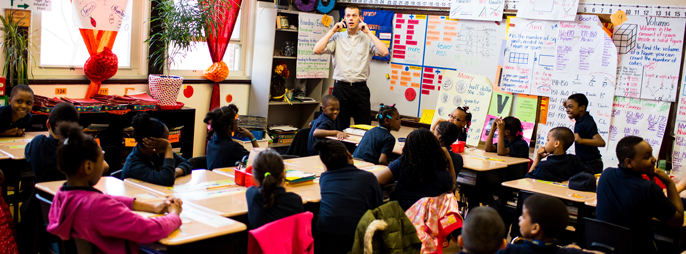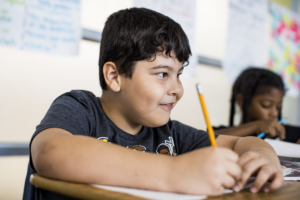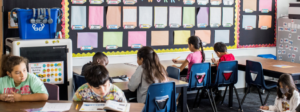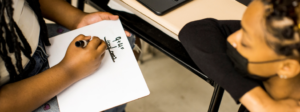Catherine Tighe taught kindergarten for six years and is now an early childhood coach for Somerville Public Schools in Somerville, Massachusetts. She is also a Teach Plus Teaching Policy Fellow alum.
Walk into most early childhood classrooms, and you’ll be bombarded with the sights and sounds of little ones giggling and chattering. You’ll find an assortment of colorful blocks, paints, books and writing tools. Kneel in a bit closer, and you’ll hear the thinking and learning children are doing as they engage with each other, their teachers and the tasks in front of them.
You probably won’t think you’re witnessing academic standards in action, or even carefully calibrated instruction. But in a skillfully crafted classroom—the kind we should want for every child—you’ll be seeing exactly that. A great pre-K classroom starts with a skilled educator who combines a thorough understanding of child development, high expectations, and creativity to create a rich, challenging and joyful environment for exploration and learning.
Doing so is complex work. I taught kindergarten for six years before becoming an early childhood coach for my district. Now, instead of leading my own classroom, I visit different classrooms every day, observe teachers and students in action and support teachers to improve their instruction.
With early childhood education (ECE) under a growing national spotlight, we need to consider how to define and interpret high expectations, rigor and best practices for our youngest learners. As we think through these challenges, it’s important to remember one thing about great ECE instruction: It’s the same stuff that goes into excellent teaching at any level. For teachers, that means understanding age-appropriate standards and knowing how to create an environment, curricula and activities to support children to reach those goals in engaging, meaningful ways.
In a classroom I visited recently, I saw this in action. Two children kicked off a game of “three bears” at the playdough center, carefully negotiating roles: “I’ll be the bears and you be the little girl.” Overhearing them, another child darted over to the classroom library, picked out Goldilocks and the Three Bears, and joined them, declaring, “I want to be the Mama Bear!” At first, her classmates hesitated to forfeit one of the coveted roles, but after some consideration, they agreed. One student handed out popsicle sticks, one for each character. The others pushed, pinched and rolled out the dough, establishing the foundation for a house and woods. They poked toothpicks and popsicle sticks into the dough to make an outline for the bears’ house. Then they jumped into the storyline, taking turns based on their roles.
Meanwhile, their teacher popped by and jotted some notes. A little while later, she returned and pulled a chair closer to prompt a conversation: “Tell me what your story is about. How did you decide to make the setting? Tell me about the characters.”
At first glance, it might seem like these children had spontaneously engaged in role-playing. But in fact, their teacher had deliberately set them up for this learning experience. Here’s what I saw:
An intentional space for learning. The playdough table was bordered by shelves that served multiple purposes: holding baskets of subtle provocations, like the popsicle sticks and toothpicks, as well as partitioning off a specific area. This invited the children to enter the space and stay focused on a single storyline.
Literacy development and a scaffolded storyline. The teacher had read this story to the class multiple times, facilitated conversations about it and left the book out as a resource. The comfort of a memorable story allowed the students to think and talk more deeply about elements like characters and setting.
Social-emotional development. The ease in which students accepted multiple children into the game was the result of modeling provided by their teacher. They were learning the elements of negotiating in respectful, thoughtful ways.
Oral language development. The children had opportunities to practice conversing and using vocabulary from the story, such as “grizzly,” ”curious” and “gobbled.”
Number sense. The children were practicing their conceptual understanding of numbers and one-to-one relationships by assigning one popsicle stick to each character. They also used measurement language throughout their story, expressing an understanding of concepts like “big,” “medium” and “small.”
This is what we mean when we talk about standards in ECE. In Massachusetts, where I work, pre-kindergarten standards call for students to be able to count concrete objects and actions up to ten and recognize the attributes of length, area, weight and capacity using appropriate vocabulary. With prompting and support, students should be able to retell a sequence of events from a story read aloud, and act out characters and events. In this classroom, the teacher was able to create opportunities for students to build these skills through what looks—and feels—like authentic play.
She was also documenting—and, yes, assessing—her students’ progress toward those goals. ECE teachers are constantly observing students as they read, play and converse, capturing samples of their writing and numeracy skills (through formal and informal assessments), and documenting their social-emotional development, in order to make sure they’re on their way to meeting critical milestones.
Rigor and play have important places in ECE classrooms. For great ECE educators, making room for both isn’t a paradox: It’s what they do every day as they plan and implement their instruction and collect data along the way to make sure their students are prepared for kindergarten and beyond.








